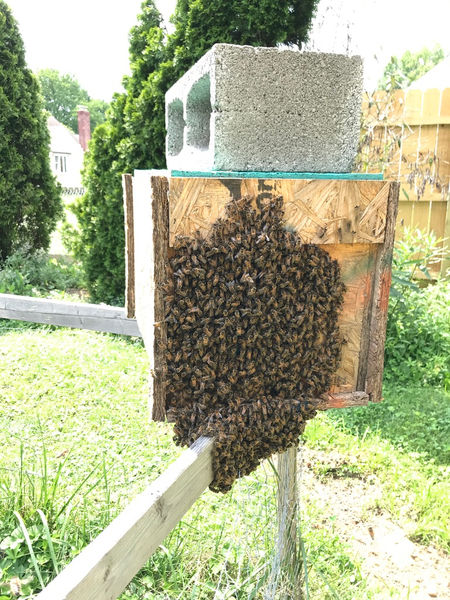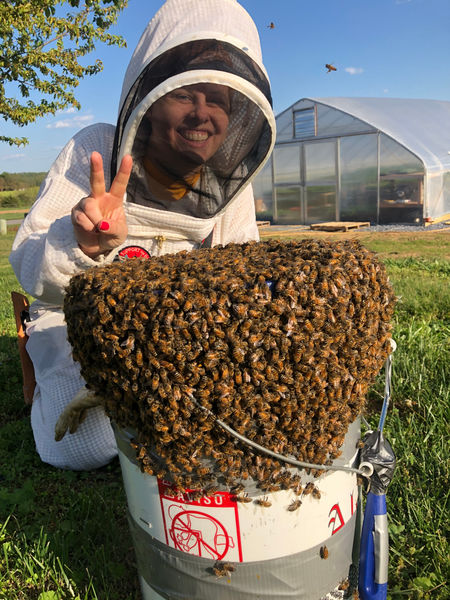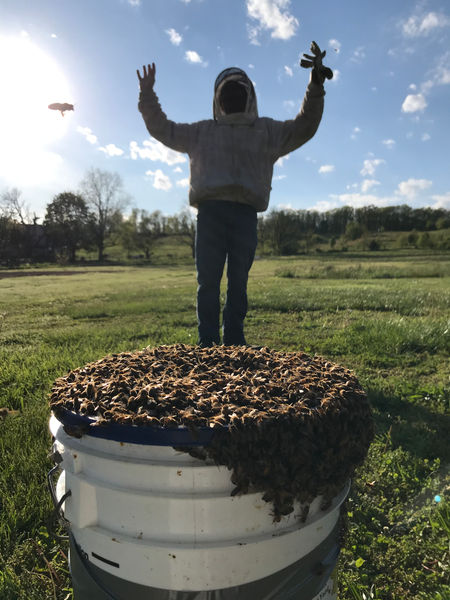HONEY BEE SWARMS
The basics and what you need to know
SWARM BASICS
The best thing you can do is leave them be, or call a beekeeper.
A swarm typically happens when the honey bee colony decides to reproduce. The colony splits itself, engorges on honey, and sets off bellies full with their queen in tow to find new accommodations. The old colony will raise a new queen to continue. The swarm will find a temporary spot to land and cluster while they send scouts to find their new spot. This cluster will look more like a vibrating blobby mass than individual bees. This is typically when the swarm is found by the homeowner or passerby. They might be at this temporary spot for a few hours or a few days (at most, but usually leave within 24hrs). The bees are extremely docile during this event. Engorged on honey and thus they are often too full to sting. They have no hive to defend and their main priority now is finding a new home. The scouts will visit ideal locations and enlist other bees to check it out and once the colony has reached a consensus, they will move on with their queen to their permanent location. Once in their new home, the bees will begin drawing comb and filling it with honey and the queen will begin laying eggs.
Honey bee swarms are most common in the spring, but may continue through summer. As we draw closer to fall honey bees may swarm if desperate, but their chances for survival dwindle.
Honey bees are least defensive during a swarming event, because they’ve engorged on honey and are often too full to sting. They have no hive to defend and their main priority now is finding a new home.
WHAT INFO YOU NEED BEFORE YOU CALL
Are you pretty sure these are honey bees (check out the pictures in our gallery)? We will only collect honey bees.
Are you the property owner?
When did you first notice the bees?
Approximate size of the cluster of bees - tangerine, grapefruit, football, basketball? Swarms come in many sizes.
What have they landed on - bush, tree, house, fence, lawn statue?
The approximate distance they are off of the ground- do we need a step stool. 4 ft later, 15ft extension ladder?
Other logistics we may need to know.
Any special concerns?
Have you called anyone else about this swarm?
Has anyone done anything to the bees - such as sprayed them with something or...?
Take some photos if possible - show us the bees and the surroundings so we can figure out how to best collect and re-home them.
When calling, first try the beekeepers listed in your zip code or county. We are located in North East Baltimore City.
REMOVALS FROM STRUCTURES
Occasionally honey bees will find their way into buildings, walls, ceilings, or other structures. Getting them out and out safely is a specialized skill. Look for someone who specifies they do “structural removals”.
We highly encourage you to only have bees removed from structure during the warmer months to ensure their survival.
Please do not call an exterminator.
WHO YOU GONNA CALL?
IS IT A HONEY BEE?
Not all yellow buzzy things are honey bees. We have over 4,000 types of native bees in North America that are not honey bees!

These are honey bees

These are NOT honey bees

These are honey bees

These are NOT honey bees

These are NOT honey bees

These are NOT honey bees

These are honey bees

These are NOT honey bees

These are honey bees
NOT HONEY BEES?
Unfortunately we can't help you with those, but here are a few resources that may help
WANT TO LEARN MORE?
If you want to see some super cool native bees and more check out Sam Drodge's work at The USGS Native Bee Inventory and Monitoring Program
The Bees in Your Backyard: A Guide to North America's Bees by: Joseph S. Wilson and Olivia J. Messinger Carril
CARPENTER BEES
a few tips to get them to move on without killing them https://oldworldgardenfarms.com/2020/05/31/stop-carpenter-bees-naturally/
GROUND NESTING BEES
Generally pretty chill, just give them space. Try placing a stone/garden statue/ fence/ or marker of sorts to remind you or visitors not to step on the nesting site. More info from Cornell University













